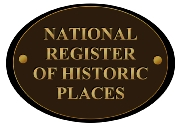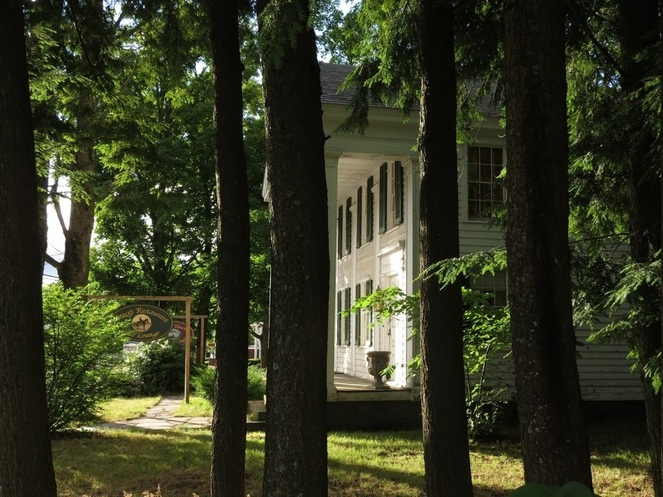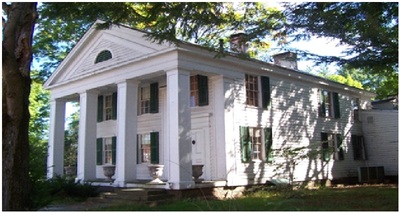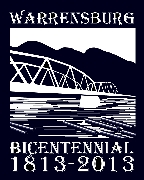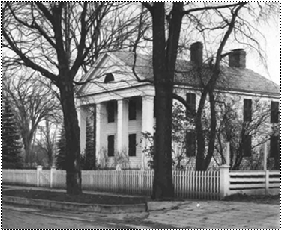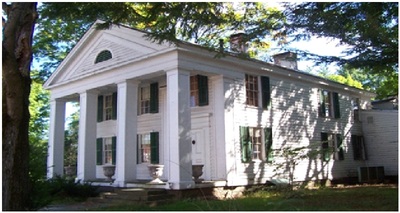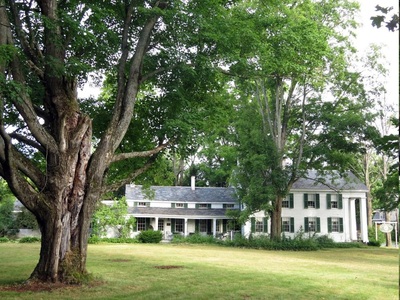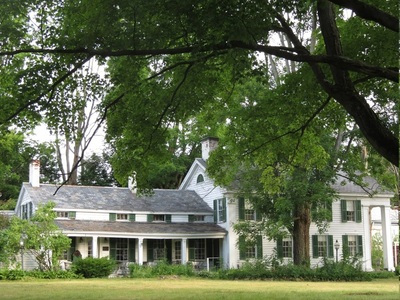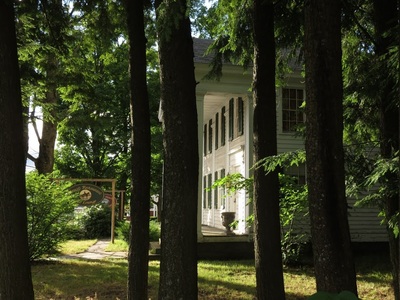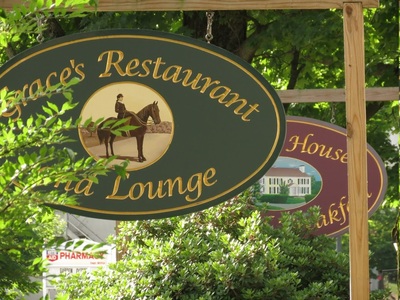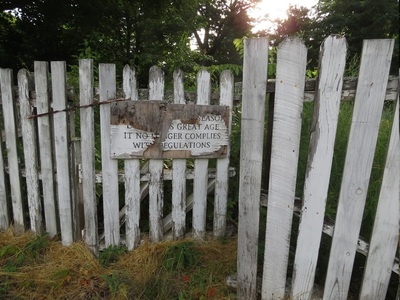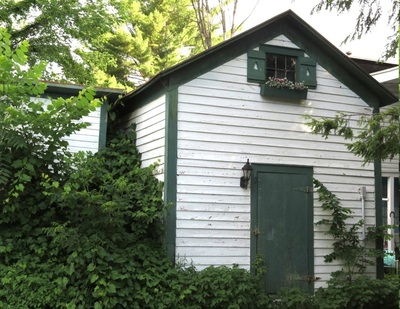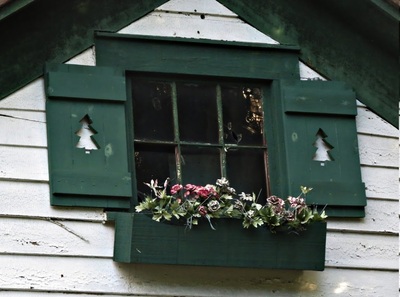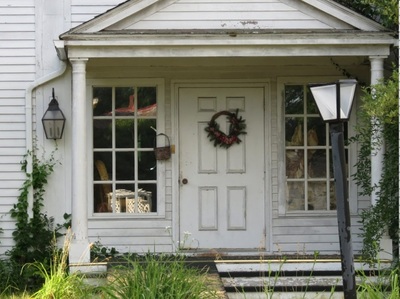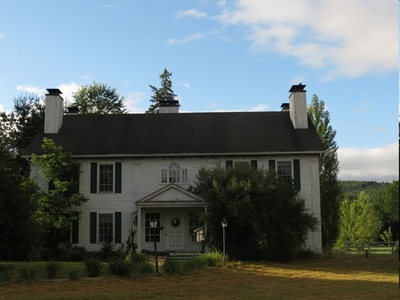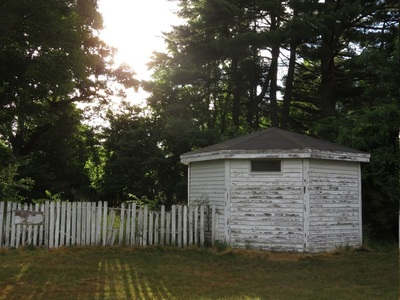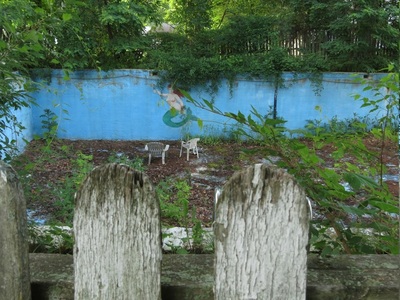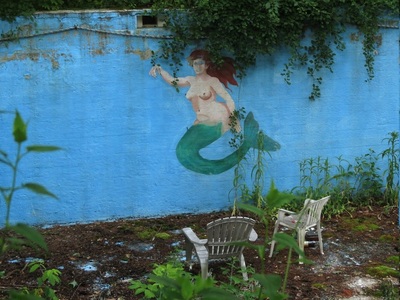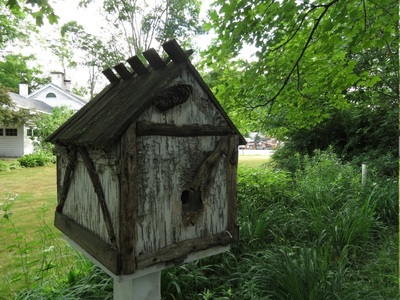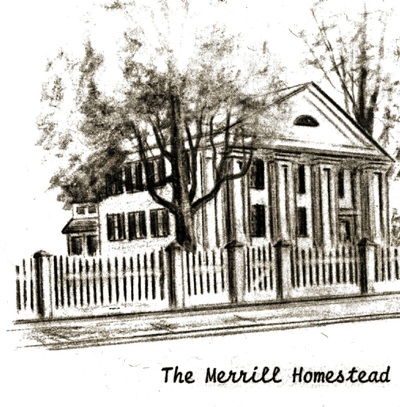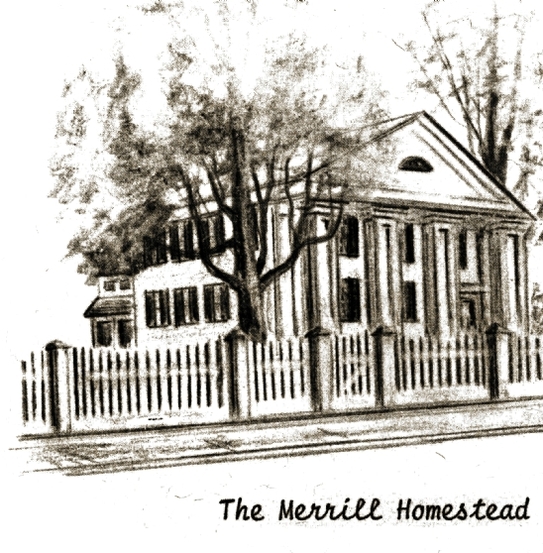This individually listed (1985) National Register property, known as the “Merrill Magee House,” consists of a c.1835 original structure with a c.1855, 2-story main block. The final addition to the building occurred after 1911, at which time a Federal period farr_nhouse built in 1815 was moved from Thurman Station and attached to the west end of the 1833 house to be used as a summer( •) kitchen. This contributing building is significant for its architectural integrity as an intact and distinguished example of Greek RevivalCJ design, and for its historic association with one of Warrensburgh’s most prominent families, the .Griffins. The house was built by Stephen Griffin, a leading entrepreneur of the Warrensburgh-Adirondack Region1 who passed the property on to his daughter, Mary Merrill, who later passed it on to Grace Merrill MaGee. Distinctive features include 2-story, 3x4 bay, gable-front form with full-fa9ade pedimented porch supported by fotir square columns. The property also includes seven contributing resources (6 bldgs/1 structure):renovated 1925 garage/servant’s quarters; 1875 carriage barn, c.l890 woodshed, ca.1875 ice house, c.1855 smokehouse, c.1927 swimming pool, c.1910 chicken coop.
The Merrill MaGee House, 2 Hudson Street, Warrensburg, is a large Greek Revival style residence sited amid historic out buildings on landscaped grounds. Located immediately southwest of the point where Hudson, Elm and Main Streets intersect, it occupies a central locat on in this small Adirondack community: Just to the north is Warrensburg’s main commercial district, while a residential district of moderate density lies to the south and east. West of the Merrill MaGee property is undeveloped woodlot and cleared land, historically associated with the Merrill MaGee House but now subdivided and slated for development. The nominated property consists of approximately 3 acres in two contiguous parcels: 1) an irregular 1-shaped lot on which the main house, woodshed, ice house, smokehouse, swinnning pool, and notable landscape features are located (This 2.65-acre parcel constitutes all the original property surviving in single ownership.); 2) an adjacent parcel of approximately one acre which includes the coach house, barn, a small chicken coop, and sufficient land surrounding them to preserve the historic setting. The boundary encompasses all the extant secondary structures and landscaping historically associated with the Merrill MaGee House and includes eight contributing features.
The Merrill MaGee House, 2 Hudson Street, Warrensburg, is a large Greek Revival style residence sited amid historic out buildings on landscaped grounds. Located immediately southwest of the point where Hudson, Elm and Main Streets intersect, it occupies a central locat on in this small Adirondack community: Just to the north is Warrensburg’s main commercial district, while a residential district of moderate density lies to the south and east. West of the Merrill MaGee property is undeveloped woodlot and cleared land, historically associated with the Merrill MaGee House but now subdivided and slated for development. The nominated property consists of approximately 3 acres in two contiguous parcels: 1) an irregular 1-shaped lot on which the main house, woodshed, ice house, smokehouse, swinnning pool, and notable landscape features are located (This 2.65-acre parcel constitutes all the original property surviving in single ownership.); 2) an adjacent parcel of approximately one acre which includes the coach house, barn, a small chicken coop, and sufficient land surrounding them to preserve the historic setting. The boundary encompasses all the extant secondary structures and landscaping historically associated with the Merrill MaGee House and includes eight contributing features.
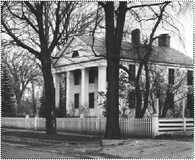
The Merrill Ma.Gee House evolved in three distinct stages: the original structure on the property consisted of a 13:2-story, frame vernacular Greek Revival style farmhouse built circa 1835. A two-story, Greek Revival style main block with giant portico was adde.d to the east end of the original house circa 1855, at which time the earlier structure became the service wing. The final addition to the house occurred after 1911, at which time a 1 stciry, frame, vernacular Federal period farmhouse built in 1815 was moved from Thurman Station to Warrensburg and attached to the west end of the 1833 house. This moved struct re, used as a summer kitchen, has acquired historical significance in its present location as a component wing of the Merrill MaGee House. A shed roofed frame kitchen was also added to the northwest side of the building (1833 section) in 1911.
The entire exterior of the Merrill MaGie House is sheathed with narrow clapboards. The gable and shed roofs of the various sections are covered with slate. Seven tall, brick interior chiiilileys rise above the roofs. The formal east elevation is dominated by a classical portico supported on square, paneled colunms. The offset entrance consists of a six panel door within a molded classical entablature. A simple frieze and cornice delineate the roofline, and pilasters define the corners and bays of the formal front. T.1e center and rear wings of the building are characterized by simple vernacular details, including one-story porches supported on simple classical wood columns and simple cornices with returns.
Fenestration throughout the house is generally regular and syrnn:e.:t_ ical, consisting of regularly spaced openings hung with movable six-over-six wood sash. The 1833 portion of the building exhibits half-story windows on the south elevation. Hany windoitJS are hung with louvered wood shutters. A louvered lunette is located in each gable end of the formal Greek Revival style addition of ca.l855.
The interior of the Merrill MaGee House retains substantial integrity of design and materials throughout. Heavy timber framing and wide plank sheathing remain in the moved Federal per’iod wing. The house of 1833 retains ;;.;ride plank wainscoting, a simple fireplace with molded mantel, warming cupboard and flanking built-in wood box, four-panel doors, and simple vernacular Greek Revival moldings. The third stage of the house contains the most stylized, classically inspired interior finish: extant original features include sliding double doors separating the parlors, molded.architraves with corner blocks, six panel doors, an ornate, late Federal molded mantel, and a stair hall which retains its original mid-nineteenth century wallpaper. The entire interior remains largely intact, in part the result of single-family ownership from 1833 to 1979.
In addition to the main house and its landscaped grounds, the nominated property includes the following historic features:
Woodshed (ca. 1890) A utilitarian, one-story, shed-roofed frame structure sheathed with novelty siding, the building is located immediately northwest of the l’1errill-HaGee House and was used to store household firewood.
Ice House (ca. 1875) A one-story, gable-roofed structure sheathed with clapboards, the modest frame building was used to store bulk ice harvested during winter from the nearby Hudson River.
Smokehouse (ca. 1855) A small, six-foot-square brick structure with a slate roof, this minor dependency stands on a cut stone floor and foundation.
Carriage Barn (ca. 1875) A two-story rectangular frame barn sheathed with clapboards, the gable-roofed barn housed vehicles and horses during the nineteenth century.
Garage/Servants’ Quarters (ca. 1925) A two-story frame building sheathed with clapboards, the building contains three round-arched garage bays on the firost story and servants’ quarters on the second story. The building is covered by a slate gable roof.
An additional garage bay for agricultural equipment is contained in an -addition (ca. 1940) attached to the south corner of the larger garages.
Swimming Pool (1927-28) A poured concrete structure measuring 40 by 80 feet, this is believed to be one of the oldest and largest home swimming pools surviving in upstate New York.
Chicken Coop (ca. 1910)A small, wood frame chicken coop lies southeast of the barn.
Landscaping The immediate surroundings of the house consist of landscaped grounds accented by ornamental shrubbery and shaded by large specimen maple and oak trees. A scalloped board fence lined with matched Norway maple trees planted in the 1930's separates the nominated property from the street.
The Merrill MaGee Hous-e is significant for its architecture and for its historical association with one of Warrensburg’s most prominent families for nearly 150 years. Consisting of a frame, vernacular Greek Revival style farmhouse of the 1830's, a monumental Greek Revival style addition of ca. 1855, and a rear wing built c.1855.
The original house on the property was built in the early
1830's and acquired by Stephen Griffin II in 1838. A leading industrial entrepreneur of the Warrensburg-Adirondack Region, Griffin owned and managed a series of tanneries, sawmills, and timber companies, achieving a reputation for his business acumen and personal integrity. Stephen Griffin was also important for his civic career,which included serving three terms as town supervisor, election to the New York State Assembly, and appointment as state agent for timber lands in Warren and Hamilton Counties. His •vernacular Greek Revival style residence is significant as a reflection of regional architectural trends during the formative years of Griffin’s career in Warrensburg. With its half-story windows, broadporch, and finely crafted interior details, the house represents the typical middle-class residence of its region and period.
As Griffin’s industrial enterprises succeeded and his wealth accrued, the family built a large and imposing addition to the existing residence, With its monumental street facade consisting of a giant portico and classical pilasters, the ca. 1855 addition turned the residence into the most stylish mid-nineteenth century structure in Warrensburg. It remains an outstanding and rare regional example of monumental Greek Revival residential architecture.
During the subsequent decades of prosperity for the Griffin family, the property underwent a gradual transition from farm tQ estate as lawn and garden areas were developed around the fashionable house. After Stephen Griffin’s death in 1893 the house passed to his daughter Hary Merrill who only used the property as a summer home. The house remained little altered until it was inherited by Grace Herrill HaGee in the early twentieth century. Grace Ms.Gee was a wealthy and sophisticated New Yorker who maintained a nostalgic affection for her ancestral home. tike her parents, she used the Warrensburg house as a summer home, but-under her ownership it was developed into a picturesque country retreat which combined such rustic delights as sheep-dotted meadows and fresh eggs with more sophisticated . innovations, including a large swimming pool. Because of her strong antiquarian and genealogical interests, Grace 1aG:=e acquire’d a portion of the Griffin family homestead in Thurman, moving it to Warrensburg in 1912. This vernacular Federal style structure was built ca. 1815 either by the first Stephen Griffin, a Revolutionary War veteran who settled Military Bounty lands at Thurman Station in 1800, or byhis son Hillial’!l. Used as a summer kitchen addition to the Warrensburg house,it reflects early nineteenth century design and construction characteristics and close historical association with the Griffin MaGee family presence in the Warrensburg region. During her lengthy ownership of the property, Grace HaGee preserved the historic design of the main house but addea an imposing Colonial Revival style garage, an immense poured concrete swimming pool, and such significant landscape features as cutting gardens, perennial borders, and boundary trees.
The continuity of family ownership from 1838 to 1979 helped to preserve the integrity of the Merrill MaGee House and its dependencies. The land was divided many times during that period, and most of the Griffin property was separated from the house after Grace HaGee’s death in 1979. The nomination boundary is drawn to include all historic outbuildings and sufficient land to preserve the historic setting. Now operated as a restaurant and inn, the housejgrounds, and outbuildings have been carefully preserved to reflect their place in local and regional history.
The entire exterior of the Merrill MaGie House is sheathed with narrow clapboards. The gable and shed roofs of the various sections are covered with slate. Seven tall, brick interior chiiilileys rise above the roofs. The formal east elevation is dominated by a classical portico supported on square, paneled colunms. The offset entrance consists of a six panel door within a molded classical entablature. A simple frieze and cornice delineate the roofline, and pilasters define the corners and bays of the formal front. T.1e center and rear wings of the building are characterized by simple vernacular details, including one-story porches supported on simple classical wood columns and simple cornices with returns.
Fenestration throughout the house is generally regular and syrnn:e.:t_ ical, consisting of regularly spaced openings hung with movable six-over-six wood sash. The 1833 portion of the building exhibits half-story windows on the south elevation. Hany windoitJS are hung with louvered wood shutters. A louvered lunette is located in each gable end of the formal Greek Revival style addition of ca.l855.
The interior of the Merrill MaGee House retains substantial integrity of design and materials throughout. Heavy timber framing and wide plank sheathing remain in the moved Federal per’iod wing. The house of 1833 retains ;;.;ride plank wainscoting, a simple fireplace with molded mantel, warming cupboard and flanking built-in wood box, four-panel doors, and simple vernacular Greek Revival moldings. The third stage of the house contains the most stylized, classically inspired interior finish: extant original features include sliding double doors separating the parlors, molded.architraves with corner blocks, six panel doors, an ornate, late Federal molded mantel, and a stair hall which retains its original mid-nineteenth century wallpaper. The entire interior remains largely intact, in part the result of single-family ownership from 1833 to 1979.
In addition to the main house and its landscaped grounds, the nominated property includes the following historic features:
Woodshed (ca. 1890) A utilitarian, one-story, shed-roofed frame structure sheathed with novelty siding, the building is located immediately northwest of the l’1errill-HaGee House and was used to store household firewood.
Ice House (ca. 1875) A one-story, gable-roofed structure sheathed with clapboards, the modest frame building was used to store bulk ice harvested during winter from the nearby Hudson River.
Smokehouse (ca. 1855) A small, six-foot-square brick structure with a slate roof, this minor dependency stands on a cut stone floor and foundation.
Carriage Barn (ca. 1875) A two-story rectangular frame barn sheathed with clapboards, the gable-roofed barn housed vehicles and horses during the nineteenth century.
Garage/Servants’ Quarters (ca. 1925) A two-story frame building sheathed with clapboards, the building contains three round-arched garage bays on the firost story and servants’ quarters on the second story. The building is covered by a slate gable roof.
An additional garage bay for agricultural equipment is contained in an -addition (ca. 1940) attached to the south corner of the larger garages.
Swimming Pool (1927-28) A poured concrete structure measuring 40 by 80 feet, this is believed to be one of the oldest and largest home swimming pools surviving in upstate New York.
Chicken Coop (ca. 1910)A small, wood frame chicken coop lies southeast of the barn.
Landscaping The immediate surroundings of the house consist of landscaped grounds accented by ornamental shrubbery and shaded by large specimen maple and oak trees. A scalloped board fence lined with matched Norway maple trees planted in the 1930's separates the nominated property from the street.
The Merrill MaGee Hous-e is significant for its architecture and for its historical association with one of Warrensburg’s most prominent families for nearly 150 years. Consisting of a frame, vernacular Greek Revival style farmhouse of the 1830's, a monumental Greek Revival style addition of ca. 1855, and a rear wing built c.1855.
The original house on the property was built in the early
1830's and acquired by Stephen Griffin II in 1838. A leading industrial entrepreneur of the Warrensburg-Adirondack Region, Griffin owned and managed a series of tanneries, sawmills, and timber companies, achieving a reputation for his business acumen and personal integrity. Stephen Griffin was also important for his civic career,which included serving three terms as town supervisor, election to the New York State Assembly, and appointment as state agent for timber lands in Warren and Hamilton Counties. His •vernacular Greek Revival style residence is significant as a reflection of regional architectural trends during the formative years of Griffin’s career in Warrensburg. With its half-story windows, broadporch, and finely crafted interior details, the house represents the typical middle-class residence of its region and period.
As Griffin’s industrial enterprises succeeded and his wealth accrued, the family built a large and imposing addition to the existing residence, With its monumental street facade consisting of a giant portico and classical pilasters, the ca. 1855 addition turned the residence into the most stylish mid-nineteenth century structure in Warrensburg. It remains an outstanding and rare regional example of monumental Greek Revival residential architecture.
During the subsequent decades of prosperity for the Griffin family, the property underwent a gradual transition from farm tQ estate as lawn and garden areas were developed around the fashionable house. After Stephen Griffin’s death in 1893 the house passed to his daughter Hary Merrill who only used the property as a summer home. The house remained little altered until it was inherited by Grace Herrill HaGee in the early twentieth century. Grace Ms.Gee was a wealthy and sophisticated New Yorker who maintained a nostalgic affection for her ancestral home. tike her parents, she used the Warrensburg house as a summer home, but-under her ownership it was developed into a picturesque country retreat which combined such rustic delights as sheep-dotted meadows and fresh eggs with more sophisticated . innovations, including a large swimming pool. Because of her strong antiquarian and genealogical interests, Grace 1aG:=e acquire’d a portion of the Griffin family homestead in Thurman, moving it to Warrensburg in 1912. This vernacular Federal style structure was built ca. 1815 either by the first Stephen Griffin, a Revolutionary War veteran who settled Military Bounty lands at Thurman Station in 1800, or byhis son Hillial’!l. Used as a summer kitchen addition to the Warrensburg house,it reflects early nineteenth century design and construction characteristics and close historical association with the Griffin MaGee family presence in the Warrensburg region. During her lengthy ownership of the property, Grace HaGee preserved the historic design of the main house but addea an imposing Colonial Revival style garage, an immense poured concrete swimming pool, and such significant landscape features as cutting gardens, perennial borders, and boundary trees.
The continuity of family ownership from 1838 to 1979 helped to preserve the integrity of the Merrill MaGee House and its dependencies. The land was divided many times during that period, and most of the Griffin property was separated from the house after Grace HaGee’s death in 1979. The nomination boundary is drawn to include all historic outbuildings and sufficient land to preserve the historic setting. Now operated as a restaurant and inn, the housejgrounds, and outbuildings have been carefully preserved to reflect their place in local and regional history.
